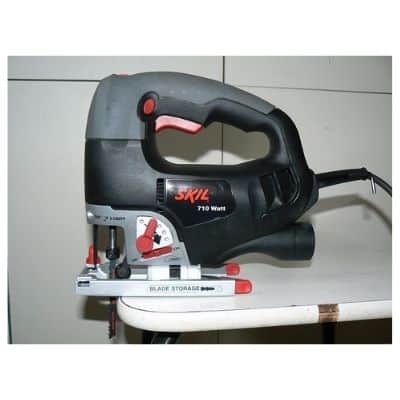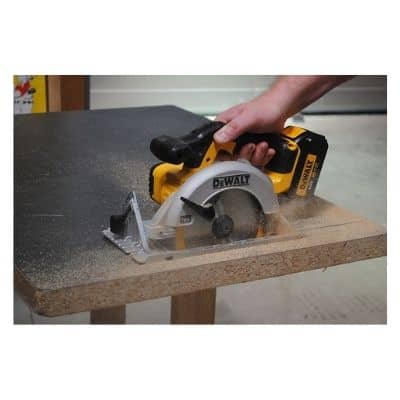In Brief: Jigsaw vs Circular Saw
Jigsaws and circular saws are both popular power tools you may need for your workshop. Jigsaws perform intricate curved and wavy cuts. Circular saws are more suited to long, straight cuts through tougher materials.
Jigsaws and circular saws serve many of the same functions. Yet, there are some key differences you should account for when making a buying decision.
Both are good choices if you are buying your first power saw. However, the type of work that you do will dictate which would prove most useful on a regular basis.
This guide will run you through the key differences between jigsaws and circular saws. This will help you decide which tool will serve you best for your next projects.
Differences Between Jigsaws and Circular Saws
| Feature | Jigsaw | Circular Saw |
|---|---|---|
| Price | $35 to $700 | $40 to $1000 |
| Design | Vertical reciprocating blade. | Circular saw blade. |
| Portability | Highly portable and lightweight. | Highly portable but heavier. |
| When to use | Intricate curved and wavy cuts. | Fast, straight cuts. |
| Versatility | Can perform a large number of cuts. | Versatile, but less so than the jigsaw. |
| Maintenance | Inexpensive blades prone to breakage. | Expensive but durable blades. |
| Ease of use | Easy to use, especially for beginners. | Requires skill to use effectively. |
| Safety | Very safe due to low power. | Moderately dangerous if used incorrectly. |
Price
Jigsaws are generally less expensive than circular saws.
Budget jigsaws can be purchased for as little as $35. Fully featured models come in around $700 at the top end, with a variety of price points in between.
Circular saws start at around $40. High end models reach about $1000 for the largest sizes.
How It Works
Jigsaws and circular saws function in completely different ways.

Jigsaws use a reciprocating vertical blade attached at one end. The blade moves up and down through the material, guided by a metal shoe. It is operated using a trigger on the horizontal handle.

Circular saws are handheld power saws with a mounted circular blade. They use a powerful motor that makes them capable of quickly cutting through all kinds of materials.
Both tools are highly portable. You can get corded or cordless varieties of both jigsaws and circular saws. Corded versions are more powerful and cheaper, but cordless varieties have the advantage of not requiring an outlet.
When to Use
Circular saws do one thing well – long, relatively straight cuts. They can perform all types of cuts but will require additional jigs, mounts and guides to achieve precision.
Jigsaws struggle with straight cuts but excel at cutting curves. It is far easier to turn a jigsaw while cutting than it is to turn a circular saw.
Circular saws can handle tougher materials with the right blade. They are often used in construction for this reason.
A jigsaw will often be found on site, too. If you are fitting a cabinet that needs to sit against an oddly shaped fixture, then a jigsaw is perfect for making it fit snugly.
Versatility
Jigsaws are versatile tools that can make a huge variety of cuts. Circular saws, while useful for many applications, are not designed for the complex cuts that jigsaws are capable of performing.
However, circular saws are more versatile when it comes to the materials they can handle. They are more powerful with stronger blades, so excel with tougher materials.
Jigsaws are capable of cutting through tough materials like metal and hard wood, but in most cases, it would be better to use a circular saw.
Maintenance
Circular saws use substantial, durable blades that will rarely need replacing.
They are mostly used for cutting straight lines. This minimizes the likelihood of breaking or damaging the blade.
Jigsaws, on the other hand, use relatively delicate blades.
They are very prone to breaking, especially as jigsaws are usually used for curved and wavy cuts. Whenever you turn a blade it risks failure.
That being said, replacement blades for jigsaws are inexpensive compared to those for circular saws. This video starts by showing you how to change the blade on a jigsaw:
Ease of Use
Jigsaws are easy to use due to their lightweight design and low power.
The blade is much smaller and imposing. Not only does this mean it is easier to use, but it is also more suitable for beginners and young woodworkers.
Circular saws are big, powerful pieces of machinery. They are noisy and messy, more suited to construction sites than workshops.
There are also a number of safety concerns you must account for when operating a circular saw. This makes them more suitable for woodworkers with a bit more experience.
Safety
The same things that make jigsaws easier to use also make them safer.
The low power, lightweight design of the jigsaw means that the chances of losing control of the tool are minimal. The blade is also smaller, so the risk of injury is lower.
Circular saws are powerful and feature a spinning blade. If the proper safety precautions are not taken it is possible to cause serious injury to yourself and to others.
However, all tools are safe to use if you follow the proper safety measures. These are usually outlined in the operator’s manual.
What Is A Jigsaw?
A jigsaw is a portable reciprocating power saw. It is commonly used for precision woodworking requiring intricate or wavy cuts.
The blade is attached at one end to a horizontal housing. The blade is quite thin which allows for fine precision but increases the risk of breakage.
Many models have speed controls that alter the speed of the vertical motion of the blade. They are considered safe and versatile tools that are suitable for beginners.
What Is A Circular Saw?
A circular saw is a portable power saw with a spinning circular blade. Circular saws excel at long, straight cuts.
They are most commonly used in construction due to its ability to make large, rough cuts. It is often considered a necessity for large construction projects such as framing a house.[
They are able to cut through all kinds of materials with the right blade attached. This includes masonry, metal and ceramics.
Summary
Now that you understand the key differences between jigsaws and circular saws it should be straightforward to decide which you need. We hope this guide has given you the confidence to pick the right tool for the job.
Do you have any more questions about the different uses of these two power saws? Or do you want to share how you are planning to use your new jigsaw or circular saw? Feel free to leave a comment in the section below.


